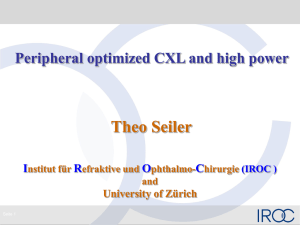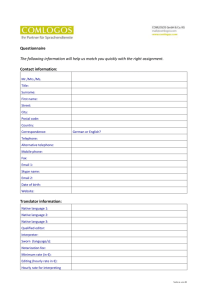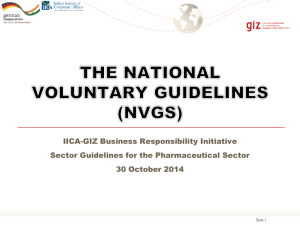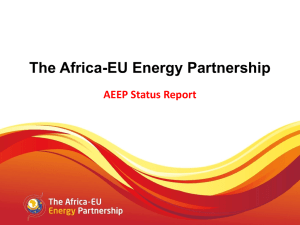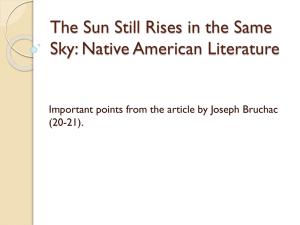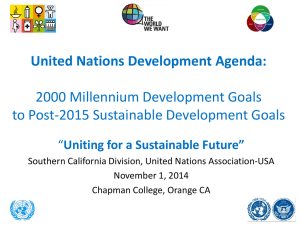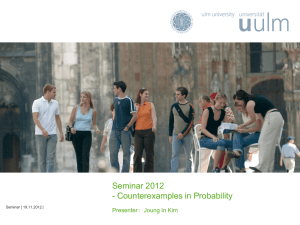Bimal Arora, GIZ.
advertisement
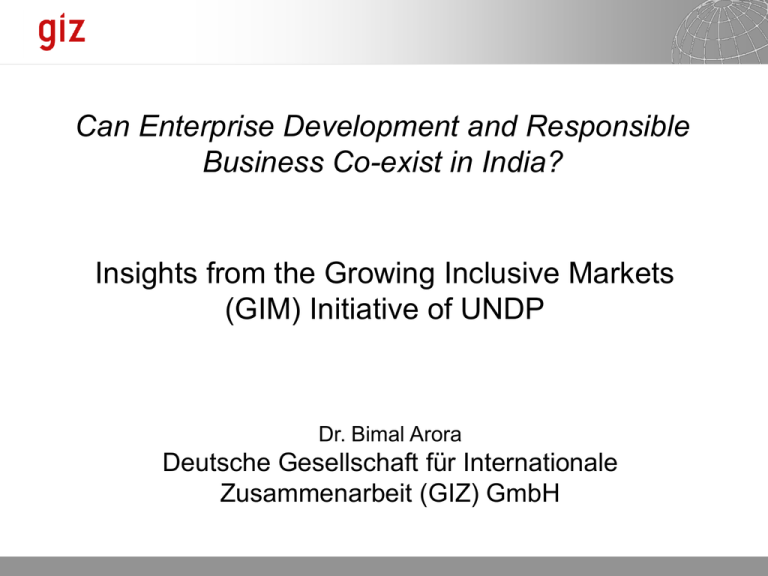
Can Enterprise Development and Responsible Business Co-exist in India? Insights from the Growing Inclusive Markets (GIM) Initiative of UNDP Dr. Bimal Arora Deutsche Gesellschaft für Internationale Zusammenarbeit (GIZ) GmbH 08.04.2015 Seite 1 The Growing Inclusive Markets Initiative Conceived by UNDP in 2006 as platform for collaboration focused on research & advocacy Vision: to enable a greater contribution of the private sector to human development and to the Millennium Development Goals GIM Role: Guiding by convening • To be a focal point for the various public and private sector initiatives in the field • To offer a roundtable to exchange views, identify common approaches and interests, understand differences and complementarities, tackle open questions • To guide a process where many actors can contribute to creating and disseminating knowledge on how business can contribute to human development Desired Impact • Raising awareness by demonstrating how doing business with the poor can be good for poor people and good for business • Clarifying the ways that businesses, governments and civil society organizations can create value for all • Inspiring the private sector to action 08.04.2015 Seite 2 Page The Growing Inclusive Markets Initiative - Advisory Board gathering over 25 key stakeholders including business associations, academic institutions and development agencies Principles • Core business emphasis • Developing world focus • Human development framework, guided by the MDGs • Local agenda • Partnership and multistakeholder approach Products • Reports (global, regional and national) • Case studies (120 commissioned + 1,000 examples) • Knowledge network: 30+ Southern academic institutions, Centers of Excellence, KM platform • Tools: Strategy Matrix, Heat Maps, Actor Framework, Training for companies and intermediaries Objectives • Deepen the understanding of how inclusive business models and inclusive markets can contribute to sustainable human development • Enable the creation of more inclusive markets by informing individual, collective and policy action to improve market environments 08.04.2015 Seite 3 Page Traditional Business (“Northern” MNCs) Approach to Development; Social Investments Development benefits CSR / Social investment Philanthropy • Contribution of financial or in-kind resources to development projects • Social investment that is strategic to the core business and that contributes to achievement of the MDGs Business benefits 08.04.2015 Seite 4 Page Private Sector is emerging as a development partner – now on the threshold of a new phase: Core Business Development benefits Inclusive business models / inclusive markets CSR / Social investment Philanthropy • Contribution of financial or in-kind resources to development projects • Social investment that facilitates business objectives and the achievement of the MDGs • Enterprise solutions that accelerate and sustain access by the poor to needed goods and services and to income generating opportunities and that contribute to economic empowerment Business benefits 08.04.2015 Seite 5 Page Core Business & Development: A Mutual Value Inclusive Business Profitability Businesses benefit from including the poor: on the supply side: finding new customers, creating long-term customer loyalty, developing transferable innovations on the demand side: improving production capacity, getting access to high-quality inputs, expanding customer reach Participation of the Poor The poor benefit from participating in markets: access to goods and services access to income opportunities as suppliers, employees, distributors and entrepreneurs increased choice and power Human Development Impact The goods & services provided have a human development impact: water & sanitation, energy financial services, ICTs housing, education, nutrition Sustainability Inclusive businesses contribute to social & environmental sustainability clean energy, protection against natural disasters fight against rural exodus and hyperurbanization etc… Many examples show that providing basic goods & services as well as income opportunities to the poor can be a sustainable and profitable business strategy and contribute to human development. 08.04.2015 Page Seite 6 Opportunities exist to build bridges between business and the poor The poor harbour a potential for consumption, production, innovation and entrepreneurial activity that is largely untapped 2.6 billion people live on less than US$ 2 per day; 1 billion lack access to clean water; 2.6 billion lack adequate sanitation; 1.6 billion lack access to electricity; 5.4 billion have no access to internet Inclusive business models include the poor on the demand side as clients and customers, and on the supply side as employees, producers and business owners in the value chain Sectors: energy, water & sanitation, agriculture, health, financial services, ICT, handicraft, education, housing, tourism Types of organizations: MNCs, large companies (public/private), MSMEs, cooperatives, NGOs, social business Inclusive business models create a win-win scenario between business and the poor Benefits for business: generating profits, creating innovation, developing new markets, strengthening supply chains Benefits for the poor: meeting basic needs, increasing productivity and incomes, empowering communities 08.04.2015 Seite 7 Page IBM: Results Framework Inclusive business models have results... ... on different stakeholders ... ... in different domains ... ... along the life cycle. 8 08.04.2015 Seite 8 Page Actor Framework Policymaking institutions Policies, infrastructure Institutions with complementary capabilities Expertise Networks Incentives, PPP Awareness raising, best practices Inclusive Business Models Patient capital, grants Tools, knowledge hubs Research & Advocacy institutions Equity, debt financing Finance institutions 08.04.2015 Seite 9 Page How can Core Business contribute to Development: Example from the mobile telephony market Access to mobile phones Increased income for farmers through instant market information (e.g. RML, India; Manobi, Senegal) Faster access to healthcare services for remote areas (e.g. Voxiva in Peru, Pesinet in Mali) Source of income and empowerment for women (e.g. GrameenPhone ladies) Access to financial services through mobile banking (e.g. ALW, India; Celpay, DRC) Reduced digital divide and increased economic growth From Unmet Demand to Business Opportunity Africa (especially SSA) is the region that offers most promise in the telecom sector Africa’s mobile phone market is one of the fastest growing in the world (40% growth in 2006) Penetration rates are still very low (less than 15%) Mobile phone subscribers in Africa could increase to 250 million in the next 4 years 08.04.2015 Seite 10 Page 2008 Report – Main Messages 1 Opportunities exist to build bridges between business and the poor and create value for all. 2 Capturing these opportunities is challenging due to five widespread market constraints in the rural villages and urban slums where the poor live. 3 Entrepreneurs have used five core strategies to overcome these constraints. 4 Business leaders, but also governments, donors, NGOs, communities and other stakeholders can take action to create value for all and make markets more inclusive. 08.04.2015 Seite 11 Page Strategy Matrix Strategies Adapt products and processes Invest in removing constraints Leverage the strengths of the poor Combine resources and capabilities with others Engage in policy dialogue with government Constraints Market information Regulatory environment Physical infrastructur e Knowledge & skills Access to financial products and services 08.04.2015 Seite 12 Page GIM Reports “Creating Value for All: Strategies for Doing Business with the Poor” (2008) “Business Solutions to Poverty – How inclusive business models create opportunities for all in Emerging Europe and Central Asia” (2011) “The MDGs: Everyone’s Business” (2010) “Estrategias Empresariales para la Superación de la Pobreza y la Exclusión en Colombia” (2010) 08.04.2015 Seite 13 Page GIM Case Study Database 08.04.2015 Seite 14 Page Case Study #1: SELCO (India) “We set up SELCO to bust 3 myths: the poor cannot afford technology, the poor cannot maintain technology and it is not possible to run a commercial venture that fulfills a social objective.” - Dr. Harish Hande, Founder Description Opportunity: most of India’s rural population does not have access to electricity; 400 million depend on highly polluting and inefficient sources of energy, thus hindering productivity Business model: make solar lighting technology accessible to the rural poor (Karnataka) through credit Constraints: • Negative perception about solar technology • Different clients’ needs and payment capacities Solutions: • Demonstration effects: maintained solar street lights to demonstrate viability of the technology • Customized products (e.g. head lamps for midwives and flower pickers) and payback options Results Partners Suppliers: Tata BP, Shakti Electronics, Anand Electronics Investors: IFC, USAID, E+Co, Lemelson, Good Energies Foundation Loans: rural banks, credit cooperatives, MFIs Social: provision of solar lighting to >110,000 rural homes and 4,000 institutions (orphanages, clinics, schools), creation of jobs (170) and income opportunities for the rural poor (entrepreneurs renting SELCO lamps to street vendors daily), savings in energy costs, improved children’s education and health. Classification Environmental: non-polluting and renewable source of energy Inclusion: Consumer, Entrepreneur Economic: 25 service centers, average sale price of INR 20,000, broke even after 7 years, now worth INR 150 million, won national and international awards Implementation: SEWA Sector: Energy Type: MSME 08.04.2015 Seite 15 Page Thank your for your attention For more information: www.growinginclusivemarkets.org E-mail: bimal.arora@giz.de 08.04.2015 Seite 16 Page


